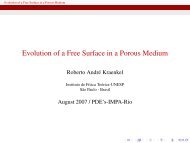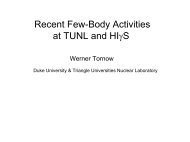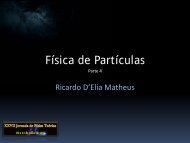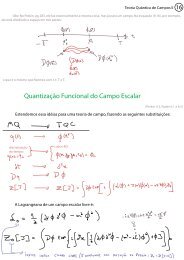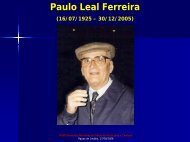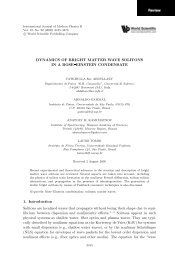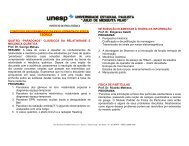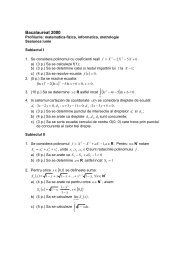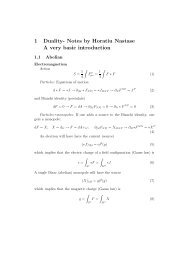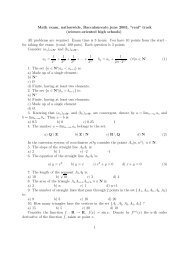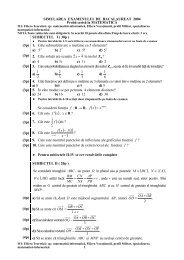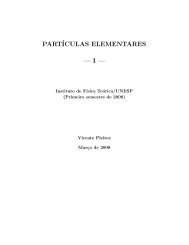Curriculum Vitae Horatiu Stefan Nastase - IFT - Unesp
Curriculum Vitae Horatiu Stefan Nastase - IFT - Unesp
Curriculum Vitae Horatiu Stefan Nastase - IFT - Unesp
Create successful ePaper yourself
Turn your PDF publications into a flip-book with our unique Google optimized e-Paper software.
<strong>Curriculum</strong> <strong>Vitae</strong><br />
<strong>Horatiu</strong> <strong>Stefan</strong> <strong>Nastase</strong><br />
Address:<br />
Instituto de Fisica Teorica,<br />
UNESP- Universidade Estadual Paulista,<br />
R. Dr. Bento Teobaldo Ferraz 271 - Bl. II,<br />
Barra Funda, Sao Paulo, SP 01140-070, Brazil<br />
e-mail: nastase@ift.unesp.br<br />
tel: +55 (11) 3393 7813 (office)<br />
Personal data:<br />
Citizenship: Romanian<br />
Birth date: March 25, 1972<br />
Marital status: Single<br />
Education:<br />
∙ PhD in Physics, 1996−2000. C. N. Yang Institute for Theoretical<br />
Physics, S.U.N.Y. Stony Brook (Now: Stony Brook University),<br />
Advisor: Prof. Peter van Nieuwenhuizen<br />
PhD in May 2000, with thesis “Connections between supergravity and<br />
gauge theory from supersymmetry and string theory”<br />
∙ 1994-1996 Niels Bohr Institute, Copenhagen, Denmark, exchange student<br />
(1994-1995)/ research (1995-1996).<br />
Advisor: Prof. Poul Olesen<br />
∙ 1990-1995 Licentiate’s in Physics (5 year degree), Physics Dept., Bucharest<br />
University. Last year at Niels Bohr Institute for thesis work.<br />
Thesis title: ’The notion of particle and spacetime geometry in superstring<br />
theories’<br />
∙ 1986-1990 ’Nicolae Balcescu High School for Physics and Mathematics’,<br />
Bucharest, Romania
Professional employment<br />
∙ Researcher III (permanent position roughly equivalent to Assistant<br />
Professor level), Jan.6 2010-now, <strong>IFT</strong>-UNESP, Sao Paulo, Brazil<br />
∙ Assistant Professor of Physics (tenure-track) Nov. 2006- December 31,<br />
2009; Global Edge Institute, Tokyo Institute of Technology<br />
∙ Assistant Research Professor of Physics (long term postdoc): Sept.2003-<br />
Sept. 2006; Brown University<br />
∙ Postdoctoral Research Associate: 2002-2003; Brown University<br />
∙ Member (Postdoctoral Research Associate): 2000-2002; Institute for<br />
Advanced Study, Princeton.<br />
∙ Research Assistant: 1997-2000, S.U.N.Y. Stony Brook<br />
∙ Teaching Assistant: S.U.N.Y. Stony Brook<br />
– Fall 1996 Semester. Undergraduate introductory course in Physics:<br />
teaching lab and grading.<br />
– Fall 1998 Semester: (for completion of PhD requirements) Quantum<br />
Mechanics, Assistant to Prof. C.N. Yang<br />
Teaching:<br />
∙ <strong>IFT</strong>: graduate course on AdS/CFT, jointly with Nathan Berkovits.<br />
∙ TITECH and Tokyo Metropolitan University:<br />
graduate student intensive course on AdS/CFT.<br />
∙ Brown University:<br />
Graduate student reading courses: General Relativity; Black holes<br />
and Supergravity. Physics 4 (electromagnetism, optics, introduction<br />
to quantum and atomic theory; for science majors outside physics,<br />
predominantly pre-med), Summer 2004 and 2005, Brown University.<br />
Physics 4 Course Manager, Spring 2005.<br />
∙ Stony Brook University: TA for pre-med Physics (Fall 1996) and TA<br />
for Quantum Mechanics (Fall 1998).
Grants<br />
∙ Start-up grant for Global Edge Institute, 2006-2008<br />
∙ KAKENHI (Japanese government) competitive grant, 2008-2010<br />
Postdoctoral Researchers supervised (hired from my grant)<br />
∙ Dumitru Astefanesei<br />
∙ Suguru Dobashi<br />
Academic honors and prizes:<br />
-2000 Max Dresden Prize for the best theoretical thesis in the Physics<br />
Department of S.U.N.Y. Stony Brook<br />
-1995 Graduated first in my year (out of approx. 300 students) at the<br />
Physics Dept., Bucharest University (average 9.95 out of 10)<br />
-1995 Scholarship from Niels Bohr Institute for research (1995/1996)<br />
-1994 Söros Foundation Scholarship for 1994/1995 thesis study at NBI<br />
(won in department-wide competition at Bucharest University)<br />
-1990 Second Prize at the International Physics Olympiad in Groningen,<br />
Netherlands (approx. 150 High School students from over 30 countries)<br />
Review work<br />
∙ Reviewer for: Journal of High Energy Physics; Physical Review D;<br />
Nuclear Physics B; Physical Review Letters; Classical and Quantum<br />
Gravity, Progress of Theoretical Physics, Journal of Physics A.<br />
∙ Grant reviewer: NSF reviewer (USA; 4 grant proposals reviewed),<br />
FONDECYT reviewer (Chile; 2 grant proposal reviewed); FAPESP<br />
reviewer (Brazil, 2 grant proposals reviewed); NRF reviewer (South<br />
Africa; 1 grant proposal reviewed)<br />
∙ Member of selection panel- peer reviewing the “Young researchers competition<br />
in honor of John Archibald Wheeler”, January 2002<br />
∙ External committee member for MSc. defense: Jelena Smolic, University<br />
of Witwatersrand, South Africa; committee member for MSc.<br />
defense: Gustavo Machado Monteiro, <strong>IFT</strong>-UNESP, Brazil.
Professional organizations<br />
∙ Brazilian Society of Physics (Sociedade Brasileira de Fisica)<br />
Conference organizing<br />
∙ Organizer for the ”Applications of gauge-gravity duality” workshop,<br />
Stellenbosch IAS, South Africa, 8-12 December 2008.<br />
Summary of citations for my papers<br />
from SLAC SPIRES (as of July 8, 2010):<br />
∙ 47 papers (46 eligible)<br />
∙ Total number of citations: 2524<br />
∙ Renowned papers (500+ cites): 1 (B.M.N.paper)<br />
∙ Very well-known papers (100+ cites): 2<br />
∙ Well known papers (50+ cites): 7<br />
∙ Known papers (10-49 cites): 21<br />
∙ Less known papers (1-9 cites): 12<br />
∙ Unknown papers (0 citations): 3<br />
The paper with D. Berenstein and J. Maldacena (B.M.N.) has<br />
a total of 1198 citations: 239th most cited High Energy Physics<br />
(both theoretical and experimental) paper of all time (since the<br />
citation counting began).
Most important research accomplishments<br />
∙ The year 2002 paper with D. Berenstein and J. Maldacena started the<br />
string theory research area known as the ”pp wave correspondence”.<br />
We showed that by taking a certain limit of the AdS/CFT correspondence,<br />
we can obtain string theory states (not just gravity) on the<br />
gravitational side of AdS/CFT, corresponding to large charge operators<br />
on the CFT side. The limit on the gravitational side is the Penrose<br />
limit, or pp wave limit, of a curved spacetime. The ”pp wave correspondence”<br />
in turn was the precursor to the popular description of spin<br />
chains from field theory via AdS/CFT, giving a connection of string<br />
theory and condensed matter theory.<br />
∙ The 2 year 1999 papers with D. Vaman and P. van Nieuwenhuizen<br />
were the first time that a full consistent nonlinear ansatz for Kaluza-<br />
Klein reduction (consistent truncation to the supergravity multiplet)<br />
of maximal supergravity on a nontrivial compact space (in this case,
Publication record:<br />
To be published in journal<br />
1. Asadig Mohammed, Jeff Murugan and <strong>Horatiu</strong> <strong>Nastase</strong>, ’Looking for a<br />
Matrix model of ABJM,’ to be published in Phys. Rev. D, arXiv:1003.2599<br />
[hep-th]<br />
Journal publications<br />
2. H. <strong>Nastase</strong> and C. Papageorgakis, ’Bifundamental fuzzy 2-sphere and<br />
fuzzy Killing spinors,’ SIGMA 6 (2010) 058, 28 pages, and arXiv:1003.5590<br />
[math-ph]<br />
3.H. <strong>Nastase</strong> and C. Papageorgakis, ’Fuzzy Killing spinors and supersymmetric<br />
D4 action on the fuzzy 2-sphere from the ABJM model,’ JHEP 12<br />
(2009) 049 and arXiv:0908.3263 [hep-th].<br />
4. R. C. Brower, H. <strong>Nastase</strong>, H. J. Schnitzer and C.-I Tan, ’Analyticity<br />
for Multi-Regge Limits of the Bern-Dixon-Smirnov Amplitudes,’ Nucl.<br />
Phys. B 822 (2009) 301 and arXiv:0809.1632 [hep-th].<br />
5. H. <strong>Nastase</strong>, C. Papageorgakis and S. Ramgoolam, ’The fuzzy
12. K. Ito, H. <strong>Nastase</strong>, K. Iwasaki, ’Gluon scattering in
’Connections between supergravity and gauge theory from supersymmetry<br />
and string theory’, PhD Thesis, UMI-99-74922-mc (microfiche) (2000)<br />
25.<strong>Horatiu</strong> <strong>Nastase</strong>, Diana Vaman<br />
’On the nonlinear KK reductions on spheres of supergravity theories’,<br />
Nucl. Phys. B 583:211-236, 2000, hep-th/0002028<br />
26.<strong>Horatiu</strong> <strong>Nastase</strong>, Diana Vaman and Peter van Nieuwenhuizen,<br />
’Consistency of the
37.<strong>Horatiu</strong> <strong>Nastase</strong><br />
’The RHIC fireball as a dual black hole,’ hep-th/0501068.<br />
38. <strong>Horatiu</strong> <strong>Nastase</strong><br />
’The soft Pomeron from AdS-CFT,’ hep-th/0501039.<br />
39. Antal Jevicki and <strong>Horatiu</strong> <strong>Nastase</strong><br />
’Towards S matrices on flat space and pp waves from SYM,’ hep-th/0501013.<br />
40. <strong>Horatiu</strong> <strong>Nastase</strong><br />
’On fuzzy spheres and (M)atrix actions,’ BROWN-HET-1425 and hepth/0410137<br />
41. <strong>Horatiu</strong> <strong>Nastase</strong><br />
’On high energy scattering inside gravitational backgrounds,’ BROWN-<br />
HET-1424 and hep-th/0410124<br />
42. <strong>Horatiu</strong> <strong>Nastase</strong><br />
’Towards a Chern-Simons M theory of
Invited conference talks<br />
∙ The fuzzy
Public talks<br />
∙ Nuclear forces from gravitational theory: a string theory connection,<br />
public lecture (physics and non-physics audience), University of London,<br />
Queen Mary College, UK, July 2007.<br />
∙ String theory and gravity in extra dimensions, Complexity and dimensionality<br />
workshop, March 2004, Brown Univ.<br />
Colloquia<br />
∙ Perspectives in High Energy Physics: Potential impact of the LHC,<br />
Physics Department, Oslo University, Norway, April 2010<br />
∙ Using string theory to understand particle collisions, <strong>IFT</strong>-UNESP, Brazil,<br />
March 2010<br />
∙ Using string theory to understand particle collisions, Physics Department<br />
Colloquium, Tokyo Institute of Technology, Japan, October 2008.<br />
∙ Particle physics, black holes and string theory, Brown University Physics<br />
Department, January 2006.<br />
∙ String theory from gauge theory and vvs., Texas A& M Physics Department,<br />
April 2004<br />
Invited research talks<br />
∙ Fuzzy spheres and M2-M5 systems in ABJM, given at<br />
-IMPU, University of Tokyo, November 2009<br />
-Rikkyo University, November 2009<br />
-Tokyo University, Komaba, December 2009
∙ Fuzzy spheres and M2-M5 systems in BLG/ABJM theories, Albert<br />
Einstein Institute, Potsdam, Germany, July 2009<br />
∙ 1/N corrections to gluon scattering in
-Princeton University, February 2005<br />
-Brown University, February 2005<br />
-MIT, February 2005<br />
-KITP, UC Santa Barbara, February 2005<br />
-Rutgers University, March 2005<br />
-University if Wisconsin, Madison, March 2005<br />
-University of Michigan, Ann Arbor, March 2005<br />
-Yale University, September 2005<br />
∙ High energy scattering and black hole production, Brown University,<br />
September 2004<br />
∙ String theory on pp waves from SYM, Rochester U, April 2004<br />
∙ On Dp-D(p+4) systems, QCD dual and phenomenology, given at<br />
-Brown University, September 2003<br />
-Harvard University, October 2003<br />
-University of New Hampshire, November 2003<br />
∙ Towards a Chern-Simons M theory of
∙ String and matrices in flat space and pp waves from supersymmetric<br />
gauge theories, given at:<br />
-ITP, University of California at Santa Barbara, March 2002<br />
-Caltech-USC Institute for Theoretical Physics, March 2002<br />
-State University of New York at Stony Brook, March 2002<br />
-Rockefeller University, March 2002<br />
-Ohio State University, April 2002<br />
-Rutgers University, April 2002<br />
∙ A 3d gauge theory with dynamical susy breaking and its supergravity<br />
dual, Princeton University, June 2001<br />
∙ Consistent nonlinear KK reductions on spheres and the AdS-CFT correspondence,<br />
given at:<br />
-University of Michigan at Ann Arbor, December 1999<br />
-Syracuse University, January 2000<br />
-Brown University, January 2000<br />
Detailed description of research accomplishments<br />
Experimental predictions of string theory via QCD: the Froissart<br />
bound, the soft Pomeron and the RHIC fireball. We found that<br />
black hole production in the string theory gravity dual is mapped to the “soft<br />
Pomeron” behaviour of the total QCD cross section at large
stand for hadrons, whereas the boosted solutions collide and form black hole<br />
like-solitons.<br />
Recently, we have found that the same dual black hole physics, described<br />
by the Pomeron, describes vector meson photoproduction, and we have obtained<br />
a prediction for a thermal distribution of vector meson cross sections,<br />
which is satisfied within experimental limits.<br />
String theory in flat space and pp waves from Super Yang Mills;<br />
lightcone string field theory; Matrix models (based on B.M.N. paper)<br />
We found that the string spectrum in flat space and on paralel plane<br />
gravitational waves arises from the large N ’t Hooft limit of
for M theory. We proposed that the vortex solution of the 3d CS theory acts<br />
as a spacetime supergraviton, and that other solutions can be interpreted as<br />
other types of branes in the spacetime theory. The results are inconclusive,<br />
since scattering of supergravitons and scattering of vortices seem to give<br />
different results, though possibly due to different applicability.<br />
Clarification of Horava gravity I have shown that Horava gravity, a<br />
theory of gravity modified in the UV, where it does not have general coordinate<br />
invariance, reproduces Einstein gravity in the IR on physical scales<br />
only if one adds an independent cosmological constant. I have also found the<br />
Schwarzschild-like solution in this case.<br />
Gluon scattering in
ABDK one is valid in
has a cosmological constant already in 11d which could explain the observed<br />
cosmological constant, giving an extra justification for the theory, together<br />
with interesting cosmologies.<br />
Towards a holographic dual of QCD and braneworld models I<br />
have identified a way to keep only fundamental fermions and no adjoint<br />
fermions in the gravity-gauge holography. A holographic dual of a nonsupersymmetric<br />
theory with fundamental fermions and no adjoint fermions was<br />
found, and a candidate QCD dual was described (although the gravity solution<br />
was not found). This construction offers new ideas for braneworld<br />
constructions of the Standard Model.<br />
Matrix model for massive IIA string theory Matrix theory gives a<br />
nonperturbative definition of string/M theory in certain backgrounds. The<br />
prototype is flat space M theory in discrete lightcone quantization, put forward<br />
by BFSS. All string theories in flat space were described in this way<br />
(together with some compactifications and some nontrivial spaces), except<br />
massive IIA. We found that the Matrix model of massive IIA is a D3 brane<br />
theory with spacetime noncommutativity, interesting in its own right. Massive<br />
IIA is also a laboratory to analyze outstanding problems like de Sitter<br />
space in string theory.<br />
Gravity dual of 3d N=1 Super Yang-Mills We analyzed various<br />
phenomena in a nonconformal gauge theory using gravity duals. The theory,<br />
arising via NS5 branes wrapped on a three-sphere, exhibits dynamical susy<br />
breaking, confinement and mass gap in various regimes. It gives a handle on<br />
the study of nonperturbative phenomena in more realistic models.<br />
A ’new’ AdS−CFT correspondence We gave a new type of relation<br />
between a string theory in
(truncation to the supergravity multiplet) of the usual 11d supergravity on a<br />
nontrivial compact space, namely
email: antal@het.brown.edu<br />
phone: +1 (401) 863 2624



